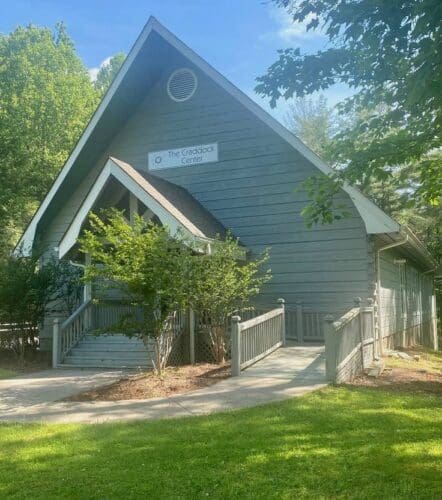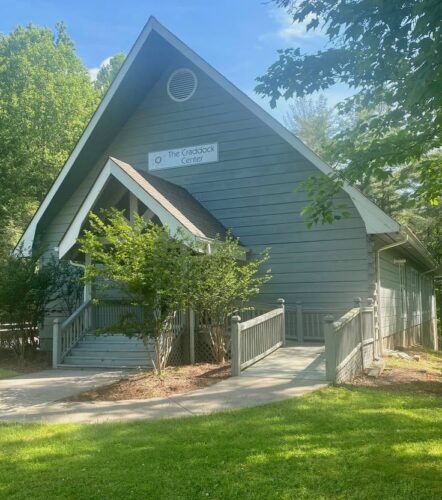
I find myself incapable of going places for very long and not finding things to experience, to ponder, and usually to write about.
I encourage my students to think theologically as they go through life, and for me it has become second nature, even on vacation.
Wanting to visit a mountain area and hike some new trails, Susan and I celebrated the end of the semester by renting a mountain cabin up a very winding road above Cherry Log, Georgia.
(Photo: Tony W. Cartledge)
I had forgotten that Cherry Log was where the inimitable Fred Craddock, famous for his “new homiletic” style of inductive preaching, made his home for many years.
Unwilling to retire altogether, while in Cherry Log he was founding pastor of the Cherry Log Church of Christ (Disciples of Christ) and served there for some time. I’ve used his Cherry Log Sermons as a supplementary textbook for preaching classes.
When someone came to him seeking help for poor children, the Craddock Center for Child and Family Enrichment was the result. In addition to helping with physical needs, the center “delivers educational and cultural programs to children, families, and communities, primarily in southern Appalachia,” according to its website.
Whenever we drove by the Craddock Center entrance adjacent to where we were staying, I couldn’t help reflecting on how a deeply red corner of Georgia could harbor a socially conscious center and a church that’s openly welcoming and affirming. Just a few miles to the east, another church sign declared the opposite sentiment: “Male and female: that’s all, folks.”
A few miles to the west, patrons can visit McCaysville Drug and Gun, whose billboard slogan boasts “Refill or Reload: We’ve Got You Covered.”
We accidentally discovered another pocket of progressive people when looking for a hiking trail somewhere between Cherry Log and Brasstown, North Carolina, so we could hike with some friends. We settled on a trail called “Project Chimps” outside of Blue Ridge, Georgia.

(Photo: Tony W. Cartledge)
Who knew that the second largest sanctuary for chimpanzees in America is located in the mountains of North Georgia? We didn’t.
Chimpanzees were declared an endangered species in 2015, bringing an end to decades of medical research in which they were unwitting subjects. Project Chimps, initially sponsored by the Humane Society of America, contracted with the University of Louisiana’s New Iberia Research Center to provide a “forever home” to the 200 or so chimps housed there.
Upgrades to a former gorilla sanctuary have allowed them to take 96 chimps so far, and they’re trying to raise enough money for additional facilities to house the remainder.
We happened to be there on a day when visitors were allowed to pay a fundraising fee and tour the facility. No cuddly chimps were on display for photo ops: they are housed in several indoor villas connected to forested outdoor areas. The former research subjects are encouraged to live freely in their own chimp society, which is not always friendly.
However wild, the chimps are treated better than many people. Humans provide carefully measured fruit, vegetables, and “chimp chow” to keep the residents healthy. Caretakers clean the indoor living areas while the chimps are outside, changing out their bedding of wood shavings. Staff members plan enrichment activities – such as hiding nuts in wadded newspaper to spur interest – to keep the chimps from getting bored, when mischief becomes more likely.
I’m glad for soft-hearted people who are putting so much effort into caring for the retired chimps, who never asked to be medical subjects, but I couldn’t help thinking of both children and elderly folk who don’t get half as much attention – and pondering ways in which I could show more care.
The Blue Ridge Mountains are beautiful, and we hiked around 33 miles of trails during the week, many of them on various legs of the Benton Mackaye Trail, named for the influential conservationist who first proposed development of the Appalachian Trail.

(Photo: Tony W. Cartledge)
On Thursday, while legging out a section to Stanley Gap, we noticed a small white flag with a caricature of a donkey and the web address www.dumassevents.com.
For a moment, we pondered why someone would name an organization “doo-mas,” but then we put the URL and the donkey together to think “Oh: dumb ass.”
It turned out that the Dahlonega Ultramarathoner’s Association – who happily refer to themselves as “dumasses” – was sponsoring a 103-mile ultramarathon along the mountain trails. We saw many more of the flags the following day while hiking the Flat Creek Loop, near the beginning and end point of the race.
The event started on Friday at noon: around 1:00 p.m. we met a large contingent of runners and walkers who were still relatively fresh. At an aid station, we learned that participants had 48 hours to complete the event – or not.
The winner came all the way from Colorado, finishing in 23:03:44, the only runner to complete the race in less than 24 hours. The second-place guy finished just over an hour later: he had come from Quebec. Other entrants traveled from as far away as Peru, France, and Japan.
The length of the race explained why all the little trail flags had reflectors on them – but they were often hundreds of yards apart. I’m guessing that running (or even walking) through the night on rugged trails laced with roots and rocks may have contributed to the “dumass” slogan: “Poor decisions make better stories.”
Of the 250 or so entrants, 122 finished in the allotted two days, the last one in 47 hours and 28 minutes. The sponsors didn’t report how many were injured or carried from the course, but we passed several pink-taped branch trails labeled as “Emergency Exits.”
I respect those who can stay awake long enough to run through the night, and I admire those who are “woke” enough to welcome and care for chimps, children, and all the world’s people, each one made in the image of God.
Good decisions can make for impressive stories, too.
Professor of Old Testament at Campbell University Divinity School in Buies Creek, North Carolina, and the Contributing Editor and Curriculum Writer at Good Faith Media.


